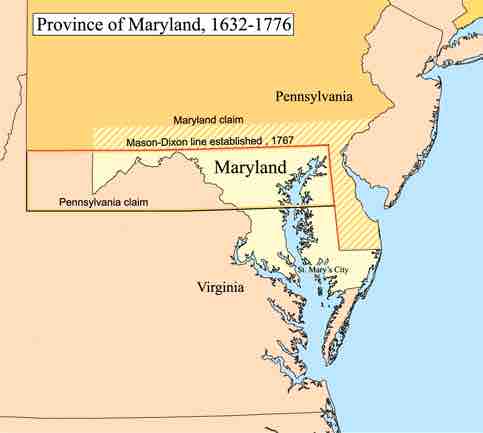Establishing Maryland
The Province of Maryland was a British colony in North America that existed from 1632 until 1776, when it joined the other 12 of the North American colonies in rebellion against Great Britain and became the state of Maryland. The province began as a proprietary colony of the English Lord Baltimore and as a haven for English Roman Catholics in the New World. Charles I of England granted the charter for Maryland to create a colony north of the Potomac to rival New Netherland's claims to the Delaware River valley.

The Province of Maryland
A map of the Province of Maryland.
Colonial Maryland was larger than the present-day state of Maryland. The original charter granted the Calverts an imprecisely defined territory north of Virginia and south of the 40th parallel, comprising perhaps as much as 12 million acres. Maryland lost some of its original territory to Pennsylvania in the 1760s when, after Charles II granted that colony a tract that overlapped with the Maryland grant, the Mason-Dixon Line was drawn to resolve the boundary dispute between the two colonies. Maryland also ceded some territory to create the new District of Columbia after the American Revolution.
The first settlers purchased land from the Yaocomico Indians and founded St. Mary's City. In 1642, Maryland declared war on the Susquehannock Indian nation and remained in an inactive state of war until a peace treaty was concluded in 1652.
Leadership
Maryland's foundational charter created a state ruled by Lord Baltimore, who directly owned all of the land granted in the charter. He possessed absolute authority over his domain; in fact, settlers were required to swear allegiance to him rather than to the King of England. The charter created an aristocracy of lords of the manor who bought land from Baltimore and held greater legal and social privileges than the common settlers.
Religion in Maryland
In Maryland, Baltimore sought to create a haven for English Roman Catholics and to demonstrate that Catholics and Protestants could live together harmoniously. Like other aristocratic proprietors, he also hoped to turn a profit in the new colony. The Calvert family recruited Catholic aristocrats and Protestant settlers for Maryland, luring them with generous land grants and a policy of religious toleration. Despite the focus on creating a safe haven for Catholics, the majority of settlers were Protestant. In 1649, Maryland passed the Maryland Toleration Act, also known as the Act Concerning Religion, a law mandating religious tolerance for Christians. Passed by the assembly of the Maryland colony, it was the first law requiring religious tolerance in the British North American colonies.
Although Maryland was an early pioneer of religious toleration in the English colonies, religious strife among Anglicans, Puritans, Catholics, and Quakers was common in the early years. From 1644 to 1646, the "Plundering Time" was a period of civil unrest caused by the tensions of the English Civil War (1641–1651). In 1654, after the Third English Civil War (1649–1651), Puritan rebels briefly seized control of the province.
The Protestant Revolution of 1689 was an event in Maryland when Puritans, by then a substantial majority in the colony, revolted against the proprietary government, in part because of the apparent preferment of Catholics to official positions of power. The Puritans set up a new government that outlawed Catholicism and deprived Catholics of all official positions. Full religious toleration would not be restored in Maryland until the American Revolution.
Life in Maryland
In the 17th century, most British settler-invaders in Maryland lived in rough conditions on small family farms. While they raised a variety of fruits, vegetables, grains, and livestock, the cash crop was tobacco, which soon came to dominate the provincial economy. Tobacco was sometimes used as money, and the colonial legislature was obliged to pass a law requiring tobacco planters to raise a certain amount of corn as well, in order to ensure that the colonists would not go hungry. Baltimore became the second-most important port in the 18th century South, after Charleston, South Carolina.
The need for cheap labor to help with the growth of tobacco led to a rapid expansion of indentured servitude and, later, forcible immigration and enslavement of Africans. In 1664, the Maryland assembly passed a "black code" which declared each Negro to be a slave for life by virtue of his color; by 1755, about 40% of Maryland's population was black.
Up to the time of the American Revolution, Maryland, along with Pennsylvania, was one of two remaining English proprietary colonies. In the late colonial period, the southern and eastern portions of the province continued their tobacco economy, but as the revolution approached, northern and central Maryland increasingly became centers of wheat production. The Province of Maryland was an active participant in the events leading up to the American revolution and echoed events in New England by establishing committees of correspondence and hosting its own tea party, similar to the one that took place in Boston.